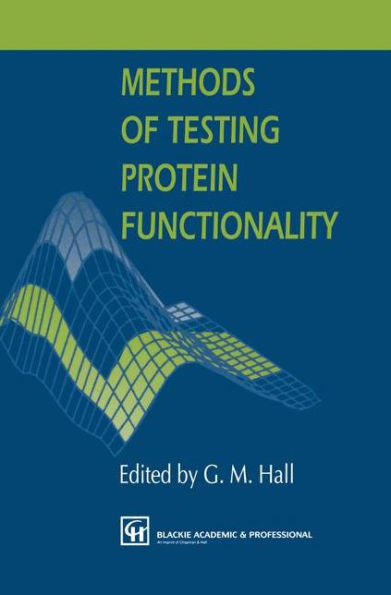Methods of Testing Protein Functionality
Protein functionality is big business in the food industry, both academic and commercial. This reflects the fascination of protein chemistry and the commercial value of proteins in giving texture and substance to foods. My first encounter with the subject came about through an interest in assessing the extent of thermal damage in spray-dried proteins. A change in functional properties seemed a useful guide to the thermal damage. I found the literature replete with methods (and theory) and so did what everybody else seemed to do - I devised my own methods which were slight variations on the general theme. However, being an analyst at heart I thought there must be a systematic approach to the various tests available. This book is an attempt to assess the practice of protein functionality testing, keeping theory to a minimum, followed by a suggested 'standard' method or prool to follow. Each chapter is devoted to a single functional property and the reader will see that attempts to 'standardise' them have had varied success, perhaps reflecting the complexity of the mechanisms at work. As mentioned above theory has been kept to a minimum but hopefully it supports the practical methodology described. I hope that the book stimulates debate on the subject; it is certainly not the last word! G. H. Contributors Dr G. E. Arteaga Centro de Investigacion en Alimentation y Desarrollo, Hermosillo, Sonora AP 1735, Mexico Dr. S.
1101313396
Methods of Testing Protein Functionality
Protein functionality is big business in the food industry, both academic and commercial. This reflects the fascination of protein chemistry and the commercial value of proteins in giving texture and substance to foods. My first encounter with the subject came about through an interest in assessing the extent of thermal damage in spray-dried proteins. A change in functional properties seemed a useful guide to the thermal damage. I found the literature replete with methods (and theory) and so did what everybody else seemed to do - I devised my own methods which were slight variations on the general theme. However, being an analyst at heart I thought there must be a systematic approach to the various tests available. This book is an attempt to assess the practice of protein functionality testing, keeping theory to a minimum, followed by a suggested 'standard' method or prool to follow. Each chapter is devoted to a single functional property and the reader will see that attempts to 'standardise' them have had varied success, perhaps reflecting the complexity of the mechanisms at work. As mentioned above theory has been kept to a minimum but hopefully it supports the practical methodology described. I hope that the book stimulates debate on the subject; it is certainly not the last word! G. H. Contributors Dr G. E. Arteaga Centro de Investigacion en Alimentation y Desarrollo, Hermosillo, Sonora AP 1735, Mexico Dr. S.
109.99
In Stock
5
1

Methods of Testing Protein Functionality
266
Methods of Testing Protein Functionality
266Hardcover(1996)
$109.99
109.99
In Stock

Product Details
| ISBN-13: | 9780751400533 |
|---|---|
| Publisher: | Springer US |
| Publication date: | 06/30/1996 |
| Edition description: | 1996 |
| Pages: | 266 |
| Product dimensions: | 6.10(w) x 9.25(h) x 0.03(d) |
From the B&N Reads Blog
